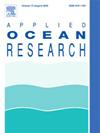Exploring bluff body geometries for enhanced energy harvesting from flow-induced vibrations using machine learning
IF 4.4
2区 工程技术
Q1 ENGINEERING, OCEAN
引用次数: 0
Abstract
This study investigates energy harvesting from flow-induced vibrations using various bluff body geometries, combining experimental techniques and machine learning for performance analysis. An electromagnetic energy harvester, featuring a permanent magnet in motion within a coil and coupled to a flexible diaphragm, was used to extract energy from vortex-induced vibrations in a flow channel. The study expands prior research by evaluating Circle, Square (at 0, 22.5, and 45 degrees), Rectangle, Trapezoid (small and large cases), and Diamond geometries across Reynolds numbers (Re = 3000, 4000, and 5000). A key innovation lies in applying six advanced machine learning models—Decision Tree, Random Forest, XGBoost, Gradient Boosting, CatBoost, and LightGBM—for voltage prediction, with a novel Weighted Ensemble method demonstrating exceptional accuracy (MAE: 0.1540, MSE: 0.0459, RMSE: 0.2141, R²: 0.9336). Experimental results revealed that Diamond and Circle geometries achieved superior energy outputs of 3.8 and 2.6 units at Re = 5000, while Trapezoid (large case) and Square at 45 degrees performed optimally at Re = 4000. This work enhances understanding of flow-induced energy harvesting, offering comprehensive insights into optimizing harvester designs through a synergy of experimental validation and machine learning predictions.
探索钝体几何形状,利用机器学习从流动引起的振动中增强能量收集
本研究利用各种钝体几何形状,结合实验技术和机器学习进行性能分析,研究了从流动引起的振动中收集能量。电磁能量采集器,其特点是永磁体在线圈中运动,并与柔性隔膜相连,用于从流道中涡流引起的振动中提取能量。该研究通过评估圆形、方形(0度、22.5度和45度)、矩形、梯形(大小情况)和钻石几何形状(雷诺数= 3000、4000和5000)来扩展先前的研究。一个关键的创新在于应用六种先进的机器学习模型——决策树、随机森林、XGBoost、梯度boost、CatBoost和lightgbm——进行电压预测,并采用一种新颖的加权集成方法,显示出卓越的准确性(MAE: 0.1540, MSE: 0.0459, RMSE: 0.2141, R²:0.9336)。实验结果表明,菱形和圆形几何形状在Re = 5000时的能量输出分别为3.8和2.6个单位,而梯形(大情况下)和45度方形几何形状在Re = 4000时表现最佳。这项工作增强了对流致能量收集的理解,通过实验验证和机器学习预测的协同作用,为优化收割机设计提供了全面的见解。
本文章由计算机程序翻译,如有差异,请以英文原文为准。
求助全文
约1分钟内获得全文
求助全文
来源期刊

Applied Ocean Research
地学-工程:大洋
CiteScore
8.70
自引率
7.00%
发文量
316
审稿时长
59 days
期刊介绍:
The aim of Applied Ocean Research is to encourage the submission of papers that advance the state of knowledge in a range of topics relevant to ocean engineering.
 求助内容:
求助内容: 应助结果提醒方式:
应助结果提醒方式:


